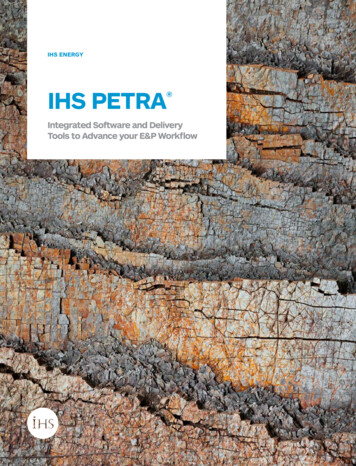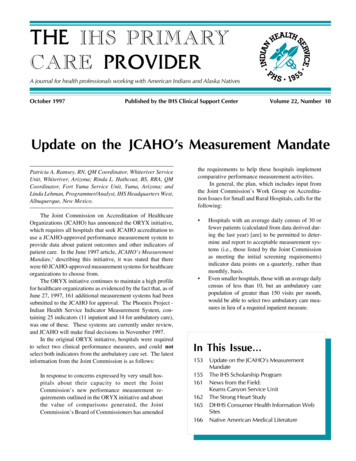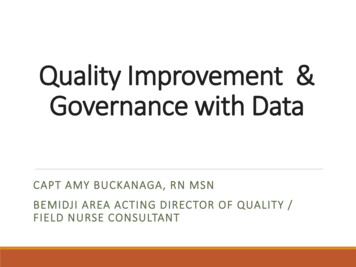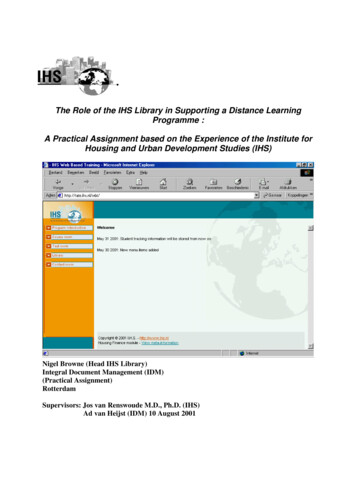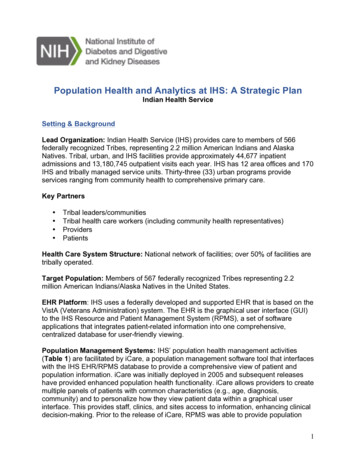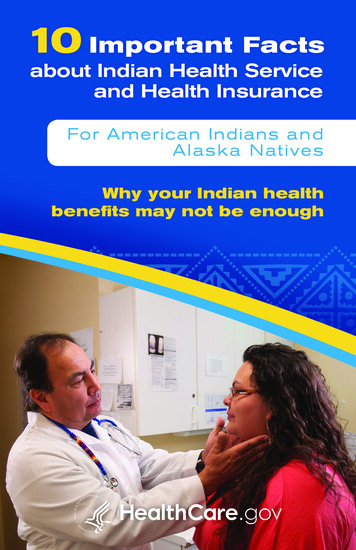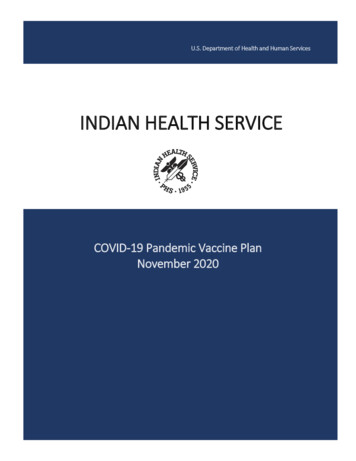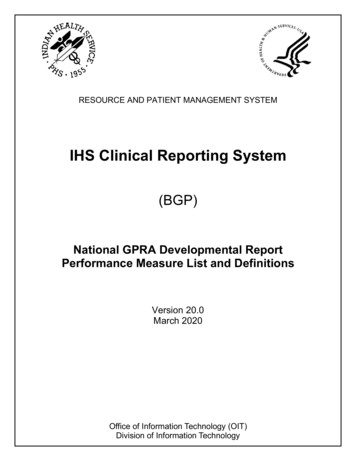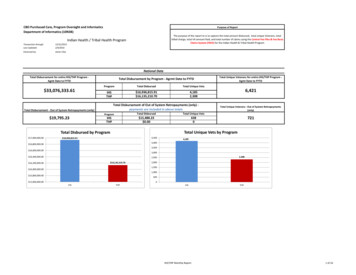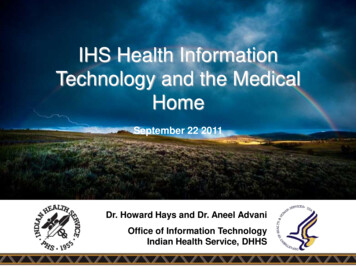
Transcription
IHS Health InformationTechnology and the MedicalHomeSeptember 22 2011Dr. Howard Hays and Dr. Aneel AdvaniOffice of Information TechnologyIndian Health Service, DHHS
Agenda Indian Health Service Context, history, and population health model Improving Patient Care PCMH Program HIT to facilitate PCMH and Pop Health RPMS and RPMS iCare Population Health Informatics in service PCMH Application Discussion/Questions
Remembering thepast continental geocultural history ofthe AI/AN & USAgencies: fromDept of War, toBIA, to IHS, toTribal SelfGovernance
American Indian Health“The federal government spends less per capita onNative American health care than on any other group forwhich it has this responsibility, including Medicaidrecipients, prisoners, veterans, and military personnel.Annually, IHS spends 60 percent less on itsbeneficiaries than the average per person health careexpenditure nationwide.”Source: A Quiet Crisis: FederalFunding and Unmet Needs inIndian CountryU.S. Commission on CivilRights, 2003
IHS User Population By ,886IHS HeadquartersRockville, MDNavajo236,893OklahomaAlbuquerque 309,54286,504Tucson24,164TOTAL IHS USER POPULATIONFOR FY 2006: 1,448,249Nashville47,379
IHS Service Population 01,400,0001,300,0001,200,0002000 20012002200320042005200620072008Average population growth rate since 2000 is 1.8% per year71% high school graduates (80% U.S.) & 10% college graduates (24% U.S.)29% of AI/ANs fall below poverty standardUnemployment is 4.0 times the US rate for males and femalesLess than 22% with self reported access to the Internet
Partnership with Tribal Governments The Indian Self-Determination Act of 1975 includes anopportunity for Tribes to assume the responsibility ofproviding health care for their members, without lesseningany Federal treaty obligation. Population HIT requires attention to complex issues ofjurisdiction in any study, change, or flow
Mortality Rates inAmerican Indians & Alaska NativesAI/AN MortalityUS All Races150100500HeartDiseaseCancer Accidents DiabetesStrokeTrends in Indian Health, 1997; Age adjustedrate per 100,000
IHS Challenges Community Normalization/ Expectations Access to Care Socioeconomic status Literacy and Access to Information Geography Transportation Alcohol/Substance Abuse Violence
IHS Service Model:Community as the PatientBroader Picture of Health: Personal HealthFamily HealthPublic HealthPopulation HealthSelf-governanceTransparency of DataPatient and community sharing of informationdemographics, environment, population data, and healthconditions
Prevalence of Diagnosed DiabetesAI/ANs compared to U.S. population1980- 19831919800YearSource: IHS Program Statistics and National Diabetes Surveillance System.Age-adjusted to the 2000 US standard population with the exception of 1981–1993 data for AIAN, which was age-adjusted to the 1980 USstandard population.
Diabetes - TranslationalPopulation PerspectiveGregg and Albright, JAMA 2009
AI/AN Relative Mortality RatesBehavior matters!Trends in Indian Health, 2003
Community as the PatientTrends in AllCause Mortality inUS for two differenttime intervalsEzzati et al. PLOSMedicine 2008
Salient Points Importance of denominators& prevention for healthimpact Denominators involvesystems thinking, behaviorchange, addressing sociocultural context and equity HIT for system change – theIHS experience of what isneeded for system change Population healthinformatics a key driver
Lack of population informatics capacity as anorganizational “deficiency” diseaseSigns and symptoms Data graveyards, data “black holes”Lots of data, little or unrelated (health system) actionNo strategic direction to leverage lots of dataBig pipes, trickles of waterLarge amount of resource investments, little impactHas systemic effects: Poor quality data fed up the chain and wreak havoc on resource allocation and decision makingImpaired organizational sense-makingCommunities prevented from leveraging natural resource: data for decisionmaking
IHS Population Health eReportingEpidemiologyAndSurveillanceMU ofHealth ITCareManagementHealth CareEffectiveness& Research
Agenda Indian Health Service Context, history, and population health model Improving Patient Care PCMH Program HIT to facilitate PCMH and Pop Health RPMS and RPMS iCare Population Health Informatics in service PCMH Application Discussion/Questions
IHS Priorities To renew and strengthen our partnership withTribes To bring reform to the IHS To improve the quality of and access to care, Ensure that our work is transparent,accountable, fair, and inclusive20
IHS IPC Program The aim of the Improving Patient Care program is to changeand improve the Indian Health system. IPC will develop highperforming and innovative health care teams to improve thequality of and access to care. Acknowledgement – IHS National IPC Program Team led byDr. Lyle Ignace, Director21
“Break Through Series” Model:Major activities of all IPC sites: Teams will receive extensive training and support in attainingthe skills and knowledge in applying methods forimprovement. Five group learning sessions Two face-to-face Two virtual web-ex based learning sessions Knowledge gathering session Action orientated initiative that provides the foundation forcontinued improvement.25
Improving Patient Care ProgramIPCNationalTeamIST TeamsLearningNetworkEvaluationIPCFoundation SeriesCollaborative26
Model for ImprovementThe Plan-Do-Study-Act (PDSA ) cycle is a process fortesting a change:(Plan) –develop a plan to test the change,(Do)- carry out the test,(Study) – observe and learn from the consequences,(Act) – determine what modifications should bemade to the test.Langley GL, Nolan KM, Nolan TW, Norman CL, Provost LP. The ImprovementGuide: A Practical Approach to Enhancing Organizational27Performance.
Indian Health Medical Home:based on Chronic Care Model(Wagner 2003)
Assure Quality of Care Health Care Organization: Create a culture, organization and mechanisms thatpromote safe, high quality care among all I/T/U health programs. Community Resources and Policies: Mobilize community resources to meetneeds of patients among all I/T/U health programs. Self Management Support: Empower and prepare patients to manage their healthand health care. Delivery System Design: Assure the delivery of care is effective, efficient for allcare teams. Decision Support: Promote clinical care that is consistent with scientific evidenceand patient preferences. Clinical Information Systems: Organize patient and population data to facilitateefficient and effective care.
IPC Levels of MeasurementMeasurement DomainMeasure IndicatorsAdult GPRA Measures:Adult:Clinical Process MeasuresDiabetes Comprehensive CareCancer-related screeningsImmunizations*Health Risk Assessments*Control Measures:Management and Prevention ofChronic ConditionsAccess to CarePatient Experience of CareControl of Blood PressureControl of LipidsControl of A1cTobacco Cessation Treatment*Diabetes CareObesity assessmentContinuity of CareER/UCC visits3rd to Next AvailableCustomer/Provider/Staff satisfaction surveySingle question: “They give meexactly the help I want (and need)exactly when I want (and need) it.”
MeasurementDomainClinicalPreventionAreas of Focus/CoverageCore Measure(s)GoalKeeping current on preventivescreeningsHealth Risk Assessment:BMI, Tobacco Screening, DV/IPV Screening,Depression Screening, Alcohol misuse screening,Blood Pressure.Cancer Screening:Colorectal Cancer Screening, Cervical CancerScreening, Breast Cancer Screening.Outcomes:Control of Blood Pressure. Control of Lipids,Control of Diabetes.80%Diabetes CareDiabetes Comprehensive Care70%Chronic illness and CancerPreventionTobacco Users (18 and older)Tobacco Users Cessation Visit in last 2 yearsCostsWorkforceStaff SatisfactionPatientExperienceExperience and EfficiencyAverage Office Visit Cycle TimeKeeping current on cancer screeningManagement andPrevention ofChronicConditionsControl of Blood PressureControl of LipidsControl of rveyQuarterly45minutesPatient Experience: Single question with sitespecific questionsBuilding Relationships for CarePercent of Patients Empanelled to a Primary CareProviderNumber of patients in the MicrosystemContinuity of Care to a Primary Care Provider90%Seeguidance80%AccessThird Next Available Appointment to a MedicalProvider0 daysPatient ActivationPercent of Patients with Self Management Goal70%Weekly
IPC “Microsystem” AIPC II – Team AColorectal Cancer -07O-07J-08A-08J-08O-08J-090
IPC “Microsystem” BColorectal Cancer ScreeningIPC II – Team -08A-08J-08O-08J-090
PDSA Cycle for Microsystems:Data is the Fuel!Model for ImprovementPDPASDAPVery SmallScale TestSDDASPPDSDPPHunchesTheories IdeasADSASASWhat change can we make thatwill result in improvement?AChanges That Result inImprovementWhat are we trying toaccomplish?How will we know that achange is an improvement?SpreadingSustaining the gainsImplementation of ChangeWide-Scale Tests of ChangeFollow-upTests34**Sequential building ofknowledge under a wide rangeof conditions**
Agenda Indian Health Service Context, history, and population health model Improving Patient Care PCMH Program HIT to facilitate PCMH and Pop Health RPMS and RPMS iCare Population Health Informatics in service PCMH Application Discussion/Questions
Resource and Patient ManagementSystem11 000101001 0110 000011 01110101 1011001010 010 00DATABASE101 11100000011110000111 101001100 0 0101 100 11110RPMShttp://www.ihs.gov/Cio/RPMS
Resource & Patient ManagementSystem IHS Health Information Solution since 1984 RPMS is an integrated Public Health information system iCare – Named 2011 “Laureate” by The Computerworld HonorsProgram EHR – Certified in April of 2011 for both inpatient and outpatient Award Winning - Davies Award/ Best of Government IT award Composed of over 60 component applications Facilitates patient, provider, community and population healthperspectives Patient and Population based clinical applications Patient and Population based practice management applications Financially-oriented administrative applications
Typical RPMS Legacy Interface
Electronic Health RecordPatient Centric GUIhttp://www.ihs.gov/cio/ehr/
RPMS: Patient Care Component
IHS Population Health eReportingEpidemiologyAndSurveillanceMU ofHealth ITCareManagementHealth CareEffectiveness& Research
IHS Population Health ApplicationsResource and Patient Management System/EHR iCare – PCMH, Pop HealthClinical Reporting SystemCANES, H1N1 SurveillanceCMET – Event TriggersImmunization ModuleNDW Clinical Repositories11 000101001 0110 000011 01110101 1011001010 010 00 101 11100 000011110000111 101001100 0 0101 100 11110RPMSDATABASE
iCare – The IHS Tool forPopulation ManagementPanel creation and population-basedalerts and reasoning43
iCare Population Management Provides an intuitive, integrated view into diverse patientdata elements for populations as well as individuals Facilitates the proactive identification and managementof populations Supports easy creation and customization of panels ofpatients Nationally deployed in May 2007 Iterative, phased development Active workgroup, change control board and SubjectMatter Expert involvement44
How iCare Fits in theRPMS WorldiCarePCCEHRRPMS
iCare and PCMH 2011PCMH 1: Enhance Access and Continuity Provides method to designate PCP Create care teams Monitor appointment wait times and officevisit timesPCMH 2: Identify and Manage PatientPopulations Create defined panel listsCreate and distribute remindersUse of disease/condition-specific registriesUse of diagnostic tagsProvides demographic informationFacilitates Community Health Rep outreachPCMH 3: Plan and Manage Care Access to RPMS data from various systemcomponents Plan care through use of reminders Provides risk factor assessment Facilitation of care management Monitor continuity of PCP and team care Includes robust behavioral health carecomponents Care plan functionality under developmentPCMH 4: Provide Self-Care Support andCommunity Resources Provide summary care pages and reports Referral to IHS online resources Facilitates Community Health Rep outreachPCMH 5: Track and Coordinate Care Create care teamsCreate defined panel listsCreate and distribute remindersMonitor continuity of PCP and team carePCMH 6: Measure and Improve Performance National Measures, GPRA, MU, IPCProvider/team//facility-level measurementsMonitor ER and UC usageMonitor local patient satisfaction
Integrated Framework forPerformance MeasurementEQUITABLE ACCESS National Priorities Partnership
IHS Quality of Care The IHS posts measures of quality on its “Quality ofCare” website for federally operated facilities. Quality measurement by health condition, facility, andoverall IHS standings encourage accountability andpromote patient participation. Current reporting streams include: ACOs 65 measures, 14 measures for value-basedpurchasing, MU 44 EP measures 15 hospitalmeasures, 38 GPRA measures, UDS reportingmeasures, and IPC 3.0 and 4.0 quality measures48
What Does IHS Measure? Improving Patient Care Meaningful Use Measures National Programs: Diabetes Dental Immunizations Cancer Screening Behavioral Health Cardiovascular Disease Prenatal HIV Screening Composite measures, including Diabetes care CVD care Cancer screening HIV quality of care49
iCare – National MeasuresComplexlogic isexecutedroutinely toidentifystatus ofadherence tothe measure
Direct Link to Patient RecordDrill down to patient specific data to see theirimmediate needs51
iCare and PCMH 2011PCMH 1: Enhance Access and Continuity Provides method to designate PCP Create care teams Monitor appointment wait times and officevisit timesPCMH 2: Identify and Manage PatientPopulations Create defined panel listsCreate and distribute remindersUse of disease/condition-specific registriesUse of diagnostic tagsProvides demographic informationFacilitates Community Health Rep outreachPCMH 3: Plan and Manage Care Access to RPMS data from various systemcomponents Plan care through use of reminders Provides risk factor assessment Facilitation of care management Monitor continuity of PCP and team care Includes robust behavioral health carecomponents Care plan functionality under developmentPCMH 4: Provide Self-Care Support andCommunity Resources Provide summary care pages and reports Referral to IHS online resources Facilitates Community Health Rep outreachPCMH 5: Track and Coordinate Care Create care teamsCreate defined panel listsCreate and distribute remindersMonitor continuity of PCP and team carePCMH 6: Measure and Improve Performance National Measures, GPRA, MU, IPCProvider/team//facility-level measurementsMonitor ER and UC usageMonitor local patient satisfaction
Team Panel DefinitionDesignate apanel as an“IPC” panel.Enhanced PanelDefinitions toaccommodateteams andmicrosystems.Additional filterswill include“Labs” and“Medications”.
IPC/Patient DetailPull “IPC” paneldata. Measuresdivided intoCore measures.
IPC/Provider Detail
IPC/Provider Aggregated
IPC/Facility Aggregated
Patient-Centered Medical Home Joint Principles 2007 Key HIT Drivers and Functions 2010*: Clinical Decision SupportRegistriesTeam CareCare TransitionsPersonal Health RecordsTelehealthMeasurement and Performance Reporting(*) Reference: Bates, D.W. and Bitton, A. “The Future Of Health. Information Technology In The Patient-Centered Medical Home,” Health Affairs http://content. healthaffairs.org/ , 29,no. 4 (2010): 614-621. ract/29/4/614)
The IHS Experience:HIT and PCMH Long-standing drivers in the care model for over 40years that are now affecting general health system Community as patient means population health IT isintegral to daily clinical work Close collaboration between clinical and nationalprograms for HIT development PDSA for HIT: Iterative cycle of development, withmodeling and coding choices entering multiple phases ofclinical quality measure development Evaluation should be a constant feature of all programand HIT deployments59
Acknowledgements National RPMS Program Team National iCare and Population Health Team National IPC Program Team DHHS collaborators and VA CPRS developers IHS innovators through the years60
Questions ?61
Extra Slides62
iCare – Background Processes Test Performed routinely - both nightly and weekly Allows for quick panel creation and data display Provides Clinical Decision Support Community AlertsFlagsRemindersPerformance MeasuresBest Practice PromptsCare Management Event TrackingMeaningful Use
iCare – Community Alerts Splash Screen at firstlogin of the day Anonymous Related to Communityof Residence Ready Access frommany views: OpeningView; Panel View;Patient Record User-defined display
iCare CANES – Community Alerts forNational Epidemiologic SurveillancePatientProviderRPMS EMRData mining using tags/flagsiCare – case surveillance and community alertsCANES nightly data extractIHS Epi DivAnalysis & report creationIHS partners(Tribal, state, federal)
EHRs and Public Health Challenges:Sentinel vs. Large-Scale Surveillance Status quo: Manual sentinelproviders; long-standingrelationships EHRs: “Large-scalesurveillance” – high fractionsof total healthcaretransactions available Issues: indicators vs. rawdata, (cross)-validation,signal-to-noise; analyticscapacity; semanticheterogeneity; causalchains; visualization; level of aggregation stateand local vs. federal needsDr. Aneel AdvaniSource: CDC Influenza Division
RPMS is an integrated Public Health information system iCare - Named 2011 "Laureate" by The Computerworld Honors Program EHR - Certified in April of 2011 for both inpatient and outpatient Award Winning - Davies Award/ Best of Government IT award Composed of over 60 component applications
